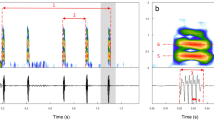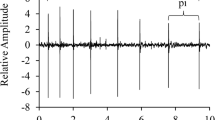Abstract
Stridulation in solifuges has not been investigated yet. We performed a comparative analysis of the stridulatory organs and sounds produced by juveniles of various developmental stages and adults (both sexes) of Galeodes caspius subfuscus Birula. The stridulatory organ is of similar morphology in all developmental stages. The sound that they produced was a broad frequency hissing, composed of one or two chirps with maximum at 2.4 kHz. The intensity of the sound was found to increase with body size. Otherwise, no differences were observed between stridulation in juvenile, male and female individuals. Therefore, we suggest that the stridulation in solifuges has primarily a defensive role. As solifuges are neither venomous nor unpalatable, they might imitate an accoustically aposematic organism that shares the same habitat and has similar circadian activity, e.g. vipers. It may also have an intraspecific function in reduction of cannibalistic tendencies.






Similar content being viewed by others
References
Acosta LE, Maury EA (1990) Estridulacion en Timogenes elegans (Mello-Leitao) (Scorpiones, Bothriuridae). Bol Soc Biol Concepcion Chile 61:29–37
Alexander AJ (1958) On the stridulation of scorpions. Behaviour 12(4):339–352
Alexander AJ (1960) A note on the evolution of stridulation within the family Scorpionidae. Proc. Zool. Soc. London 133(3):391–399
Bennet-Clark HC (1971) Acoustic of insect song. Nature 234:255–259
Birula AA (1938) Arachnides. Ordo Solifuga. Faune de L’URSS vol. I., no. 3. Institut zoologique de l’académie des sciences de l’URSS, Moscow
Cloudsley-Thompson JL (1961) Some aspects of the physiology and behaviour of Galeodes arabs. Ent Exp Appl 4:257–263
Cloudsley-Thompson JL (1977) Adaptational biology of Solifugae (Solpugida). Bull Br Arachnol Soc 4(2):61–67
Cloudsley-Thompson JL, Constantinou C (1984) Stridulatory apparatus of Solifugae (Solpugida). J Arid Environ 7:365–369
Crawley MJ (2002) Statistical Computing. An Introduction to Data Analysis Using S-Plus. John Wiley and Sons, Chichester
Dufour L (1862) Anatomie, physiologie et histoire naturelle des Galeodes. Mém Acad Sci Inst France 17:338–446
Dumortier B (1963a) Morphology of sound emission apparatus in Arthropoda. In: Busnel R-G (ed) Acoustic Behaviour of Animals. Elsevier, Amsterdam, pp 277–345
Dumortier B (1963b) Ethological and physiological study of sound emissions in Arthropoda. In: Busnel R-G (ed) Acoustic Behaviour of Animals. Elsevier, Amsterdam, pp 583–654
Edwards GB (1981) Sound production by courting males of Phidippus mystaceus (Araneae: Salticidae). Psyche 88(3/4):199–214
Gans C, Maderson PFA (1973) Sound Producing Mechanisms in Recent Reptiles: Review and Comment. Am Zool 13(4):1195–1203
Gwinger-Hanke H (1970) Zum Verhalten zweier stridulierender Spinnen Steatoda bipunctata Linné und Teutana grossa Koch (Theridiidae, Araneae), unter besonderer Berücksichtigung des Fortpflanzungsverhaltens. Z Tierpsychol 27(6):649–678
Gwynne DT, Dadour IR (1985) A new mechanism of sound production by courting male jumping spiders (Araneae: Salticidae, Sitis michaelseni). J Zool Lond 207:35–42
Hansen H (1893) Organs and characters in different orders of Arachnids. Ent Med 4:135–251
Hewitt J (1919) A short survey of the solifugae of South Africa. Ann Transvaal Museum 7:1–76
Hrušková-Martišová M, Pekár S, Gromov A (2007) Biology of Galeodes caspius subfuscus (Solifugae, Galeodidae). J Arachnol 35:546–550
Kinney C, Abishahin G, Young BA (1998) Hissing in rattlesnakes: redundant signaling or inflationary epiphenomenon? J Exp Zool 280:107–113
Kirchner WH, Röschard J (1999) Hissing in bumblebees: an interspecific defence signal. Insectes Soc 46:239–243
Legendre R (1963) L’audition et l’emission de sons chez les Aranéides. Ann Biol 2:371–390
Maddison WP, Stratton GE (1988) Sound production and associated morphology in male jumping spiders of the Habronattus agilis species group (Araneae, Salticidae). J Arachnol 16:199–211
Marshall SD, Thoms EM, Uetz GW (1995) Setal entanglement: an undescribed method of stridulation by a neotropical tarantula (Araneae: Theraphosidae). J Zool Lond 235:587–595
Masters WM (1980) Insect disturbance stridulation: characterization of airborne and vibrational components of the sound. J Comp Physiol 135:259–268
McCormick SJ, Polis GA (1990) Prey, predators, and parasites. In: Polis GA (ed) The Biology of Scorpions. Stanford University Press, Stanford, pp 294–320
Muma MH (1967) Basic behavior of North American Solpugida. Florida Ent 50(2):115–123
Pocock RI (1898) On the nature and habits of Pliny’s Solpuga. Nature 57:618–620
Punzo F (1998) Intraspecific male aggression in Arenotherus joshuaensis Brookhart and Muma, and Eremobates marathoni Muma (Solifugae, Eremobatidae). Southwest Natur 43(3):291–295
R Development Core Team (2004) R: A language and environment for statistical computing. R Foundation for Statistical Computing, Vienna, Austria. http://www.R-project.org.
Roewer CF (1934) Solifuga, Palpigrada. In: Bronns HG (ed) Klassen und Ordnungen des Tierreichs. Akademische Verlagsgesellschaft, Leipzig, pp 481–608
Šilhavý V (1978) Minuides milleri sp. n., an opilionid with an unusual manner of stridulation (Phalangodidae, Phalangodinae). Acta Entomol Bohemoslov 75(1):58–63
Uetz GW, Stratton GE (1982) Acoustic communication and reproductive isolation in spiders. In: Witt PN, Rovner JS (eds) Spider Communication: Mechanism and Ecological Significance. Princeton University Press, New Jersey, pp 123–159
Uhl G, Schmitt M (1996) Stridulation in Palpimanus gibbulus Dufour (Araneae: Palpimanidae). In Mahnert V (ed.) Proceedings of the XIIIth International Congress of Arachnology, Revue Suisse Zool. hors. Serie, pp. 649–660
Vol F (2002) Stridulation in tarantulas. J Br Tarantula Soc 18(1):21–27
Warburton C (1909) Solifugae (Solpugae). Camb Nat Hist 4:423–429
West RC (1993) Warning: do not eat the tarantulas. Forum Am Tarantula Soc 2:3–4
Young BA, Brown IP (1993) On the acoustic profile of the rattlesnake rattle. Amphib-Reptil 14:373–380
Acknowledgements
The study was supported by NATO-Science project no. LST.CLG.980430 and the projects no. ME851 and 0021622416 of the Ministry of Education, Youth and Sports of the Czech Republic. MH was also supported by project no. 20061431C008 of the Masaryk University.
Author information
Authors and Affiliations
Corresponding author
Rights and permissions
About this article
Cite this article
Hrušková-Martišová, M., Pekár, S. & Gromov, A. Analysis of the Stridulation in Solifuges (Arachnida: Solifugae). J Insect Behav 21, 440–449 (2008). https://doi.org/10.1007/s10905-008-9141-4
Revised:
Accepted:
Published:
Issue Date:
DOI: https://doi.org/10.1007/s10905-008-9141-4




